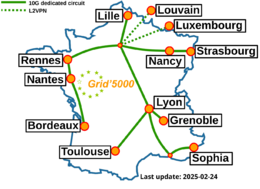Grid5000:Home
|
Grid'5000 is a large-scale and flexible testbed for experiment-driven research in all areas of computer science, with a focus on parallel and distributed computing including Cloud, HPC and Big Data and AI. Key features:
Grid'5000 is merging with FIT to build the SILECS Infrastructure for Large-scale Experimental Computer Science. Read an Introduction to SILECS (April 2018)
Older documents:
|
Random pick of publications
Five random publications that benefited from Grid'5000 (at least 2780 overall):
- Clément Courageux-Sudan, Anne-Cécile Orgerie, Martin Quinson. Studying the end-to-end performance, energy consumption and carbon footprint of fog applications. ISCC 2024 - 29th IEEE Symposium on Computers and Communications, Jun 2024, Paris, France. pp.1-7. hal-04581677 view on HAL pdf
- Adrien Berthelot, Eddy Caron, Mathilde Jay, Laurent Lefèvre. Estimating the environmental impact of Generative-AI services using an LCA-based methodology. CIRP LCE 2024 - 31st Conference on Life Cycle Engineering, Jun 2024, Turin, Italy. pp.1-10. hal-04346102v2 view on HAL pdf
- Thomas Firmin, Pierre Boulet, El-Ghazali Talbi. Parallel Hyperparameter Optimization Of Spiking Neural Networks. 2023. hal-04464394 view on HAL pdf
- Sewade Ogun, Vincent Colotte, Emmanuel Vincent. Stochastic Pitch Prediction Improves the Diversity and Naturalness of Speech in Glow-TTS. InterSpeech 2023, Aug 2023, Dublin, Ireland. hal-04108825 view on HAL pdf
- Mathieu Bacou. FaaSLoad : fine-grained performance and resource measurement for function-as-a-service. 2024. hal-04836444 view on HAL pdf
Latest news
Extension:RSS -- Error: "https://www.grid5000.fr/w?title=News&action=feed&feed=atom" is not in the list of allowed feeds. The allowed feeds are as follows: https://www.grid5000.fr/status/upcoming.atom, https://www.grid5000.fr/mediawiki/index.php?title=News&action=feed&feed=rss, https://www.grid5000.fr/mediawiki/index.php?title=News&action=feed&feed=atom and https://www.grid5000.fr/rss/G5KNews.php.
Grid'5000 sites
Current funding
As from June 2008, Inria is the main contributor to Grid'5000 funding.
INRIA |
CNRS |
UniversitiesUniversité Grenoble Alpes, Grenoble INP |
Regional councilsAquitaine |


